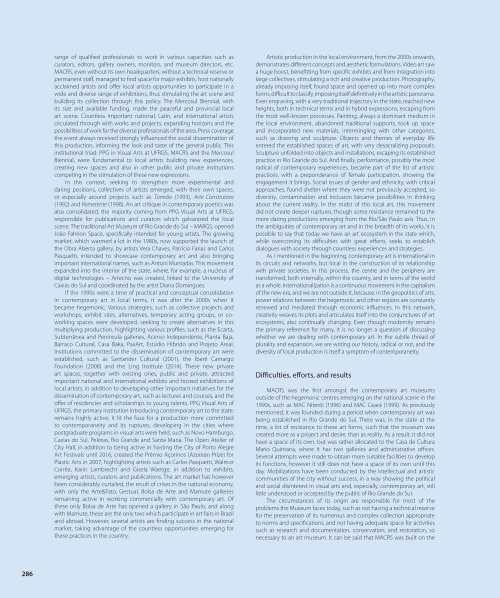Catálogo_MACRS
You also want an ePaper? Increase the reach of your titles
YUMPU automatically turns print PDFs into web optimized ePapers that Google loves.
ange of qualified professionals to work in various capacities such as<br />
curators, editors, gallery owners, monitors, and museum directors, etc.<br />
<strong>MACRS</strong>, even without its own headquarters, without a technical reserve or<br />
permanent staff, managed to find space for major exhibits, host nationally<br />
acclaimed artists and offer local artists opportunities to participate in a<br />
wide and diverse range of exhibitions, thus stimulating the art scene and<br />
building its collection through this policy. The Mercosul Biennial, with<br />
its size and available funding, made the peaceful and provincial local<br />
art scene. Countless important national, Latin, and international artists<br />
circulated through with works and projects, expanding horizons and the<br />
possibilities of work for the diverse professionals of the area. Press coverage<br />
the event always received strongly influenced the social dissemination of<br />
this production, informing the look and taste of the general public. This<br />
institutional triad: PPG in Visual Arts at UFRGS, <strong>MACRS</strong> and the Mercosul<br />
Biennial, were fundamental to local artists building new experiences,<br />
creating new spaces and also in other public and private institutions<br />
competing in the stimulation of these new expressions.<br />
In this context, seeking to strengthen more experimental and<br />
daring positions, collectives of artists emerged, with their own spaces,<br />
or especially around projects such as Torreão (1993), Arte Construtora<br />
(1992) and Remetente (1998). An art critique in contemporary poetics was<br />
also consolidated, the majority coming from PPG Visual Arts at UFRGS;<br />
responsible for publications and curators which galvanized the local<br />
scene. The traditional Art Museum of Rio Grande do Sul – MARGS, opened<br />
João Fahrion Space, specifically intended for young artists. The growing<br />
market, which warmed a lot in the 1980s, now supported the launch of<br />
the Obra Aberta gallery, by artists Vera Chaves, Patrício Farias and Carlos<br />
Pasquetti, intended to showcase contemporary art and also bringing<br />
important international names, such as Antoni Muntadas. This movement<br />
expanded into the interior of the state, where, for example, a nucleus of<br />
digital technologies – Artecno was created, linked to the University of<br />
Caxias do Sul and coordinated by the artist Diana Domingues.<br />
If the 1990s were a time of practical and conceptual consolidation<br />
in contemporary art in local terms, it was after the 2000s when it<br />
became hegemonic. Various strategies, such as collective projects and<br />
workshops, exhibit sites, alternatives, temporary acting groups, or coworking<br />
spaces were developed, seeking to create alternatives in this<br />
multiplying production, highlighting various profiles, such as the Ecarta,<br />
Subterrânea and Península galleries, Acervo Independente, Planta Baja,<br />
Barraco Cultural, Casa Baka, PaxArt, Estúdio Híbrido and Projeto Areal.<br />
Institutions committed to the dissemination of contemporary art were<br />
established, such as Santander Cultural (2001), the Iberê Camargo<br />
Foundation (2008) and the Ling Institute (2014). These new private<br />
art spaces, together with existing ones, public and private, attracted<br />
important national and international exhibits and hosted exhibitions of<br />
local artists, in addition to developing other important initiatives for the<br />
dissemination of contemporary art, such as lectures and courses, and the<br />
offer of residencies and scholarships to young talents. PPG Visual Arts of<br />
UFRGS, the primary institution introducing contemporary art to the state,<br />
remains highly active, it lit the fuse for a production more committed<br />
to contemporaneity and its ruptures, developing in the cities where<br />
postgraduate programs in visual arts were held, such as Novo Hamburgo,<br />
Caxias do Sul, Pelotas, Rio Grande and Santa Maria. The Open Atelier of<br />
City Hall, in addition to being active in hosting the City of Porto Alegre<br />
Art Festivals until 2016, created the Prêmio Açorinos (Azorean Prize) for<br />
Plastic Arts in 2007, highlighting artists such as Carlos Pasquetti, Walmor<br />
Corrêa, Karin Lambrecht and Gisela Waetge, in addition to exhibits,<br />
emerging artists, curators and publications. The art market has however<br />
been considerably curtailed, the result of crises in the national economy,<br />
with only the Arte&Fato, Gestual, Bolsa de Arte and Mamute galleries<br />
remaining active in working commercially with contemporary art. Of<br />
these only Bolsa de Arte has opened a gallery in São Paulo, and along<br />
with Mamute, these are the only two which participate in art fairs in Brazil<br />
and abroad. However, several artists are finding success in the national<br />
market, taking advantage of the countless opportunities emerging for<br />
these practices in the country.<br />
Artistic production in the local environment, from the 2000s onwards,<br />
demonstrates different concepts and aesthetic formulations. Video art saw<br />
a huge boost, benefitting from specific exhibits and from integration into<br />
large collectives, stimulating a rich and creative production. Photography,<br />
already imposing itself, found space and opened up into more complex<br />
forms, difficult to classify, imposing itself definitively in the artistic panorama.<br />
Even engraving, with a very traditional trajectory in the state, reached new<br />
heights, both in technical terms and in hybrid expressions, escaping from<br />
the most well-known processes. Painting, always a dominant medium in<br />
the local environment, abandoned traditional supports, took up space<br />
and incorporated new materials, intermingling with other categories,<br />
such as drawing and sculpture. Objects and themes of everyday life<br />
entered the established spaces of art, with very desacralizing proposals.<br />
Sculpture unfolded into objects and installations, escaping its established<br />
practice in Rio Grande do Sul. And finally, performance, possibly the most<br />
radical of contemporary experiences, became part of the list of artistic<br />
practices, with a preponderance of female participation, showing the<br />
engagement it brings. Social issues of gender and ethnicity, with critical<br />
approaches, found shelter where they were not previously accepted, so<br />
diversity, contamination and inclusion became possibilities in thinking<br />
about the current reality. In the midst of this local art, this movement<br />
did not create deeper ruptures, though some resistance remained to the<br />
more daring productions emerging from the Rio/São Paulo axis. Thus, in<br />
the ambiguities of contemporary art and in the breadth of its works, it is<br />
possible to say that today we have an art ecosystem in the state which,<br />
while overcoming its difficulties with great efforts, seeks to establish<br />
dialogues with society through countless experiences and strategies.<br />
As I mentioned in the beginning, contemporary art is international in<br />
its circuits and networks, but local in the construction of its relationship<br />
with private societies. In this process, the centre and the periphery are<br />
transformed, both internally, within the country, and in terms of the world<br />
as a whole. Internationalization is a continuous movement in the capitalism<br />
of the new era, and we are not outside it, because, in the geopolitics of arts,<br />
power relations between the hegemonic and other regions are constantly<br />
renewed and mediated through economic influences. In this network,<br />
creativity weaves its plots and articulates itself into the conjunctures of art<br />
ecosystems, also continually changing. Even though modernity remains<br />
the primary reference for many, it is no longer a question of discussing<br />
whether we are dealing with contemporary art. In the subtle thread of<br />
plurality and expansion, we are writing our history, radical or not, and the<br />
diversity of local production is itself a symptom of contemporaneity.<br />
Difficulties, efforts, and results<br />
<strong>MACRS</strong> was the first amongst the contemporary art museums<br />
outside of the hegemonic centres emerging on the national scene in the<br />
1990s, such as MAC Niterói (1996) and MAC Ceará (1999). As previously<br />
mentioned, it was founded during a period when contemporary art was<br />
being established in Rio Grande do Sul. There was, in the state at the<br />
time, a lot of resistance to these art forms, such that the museum was<br />
created more as a project and desire, than as reality. As a result, it did not<br />
have a space of its own, but was rather allocated to the Casa de Cultura<br />
Mario Quintana, where it has two galleries and administrative offices.<br />
Several attempts were made to obtain more suitable facilities to develop<br />
its functions, however it still does not have a space of its own until this<br />
day. Mobilizations have been conducted by the intellectual and artistic<br />
communities of the city without success, in a way showing the political<br />
and social disinterest in visual arts and, especially, contemporary art, still<br />
little understood or accepted by the public of Rio Grande do Sul.<br />
The circumstances of its origin are responsible for most of the<br />
problems the Museum faces today, such as not having a technical reserve<br />
for the preservation of its numerous and complex collection appropriate<br />
to norms and specifications, and not having adequate space for activities<br />
such as research and documentation, conservation, and restoration, so<br />
necessary to an art museum. It can be said that <strong>MACRS</strong> was built on the<br />
286



